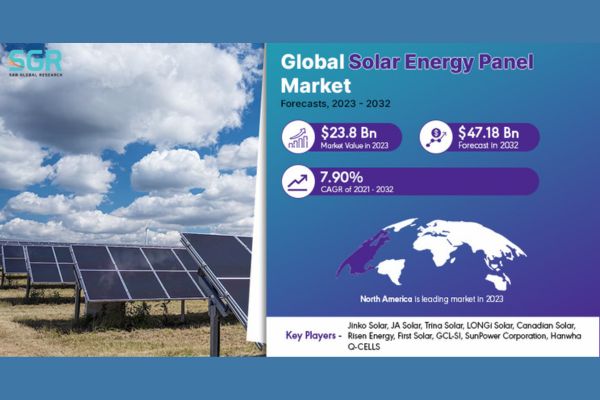According to the new report titled “Solar Energy Panel Market By Type (Monocrystalline, Polycrystalline, Thin Film), By Application (Residential, Commercial, Industrial, Utilities, Space & Defence) Global Analysis to 2023”, the valuation of the Solar Energy Panel market was $23.8 Billion in 2023 and is projected to reach $47.18 Billion by 2032, at a CAGR of 7.90% from 2023 to 2032.
The Solar Energy Panel Market was valued at $23.8 Billion by 2023 and expected to grow at CAGR of 7.90% over forecast period. Solar energy panels, commonly known as solar panels or photovoltaic (PV) panels, are devices used to convert sunlight into electricity. These panels are made up of solar cells, which are typically made from silicon-based materials. When sunlight hits the solar cells, it excites electrons, creating a flow of electricity. This electricity can be used to power electrical loads directly, stored in batteries for later use, or fed into the electrical grid. The solar energy panel market refers to the industry involved in the production, distribution, and installation of solar panels, also known as photovoltaic (PV) panels. These panels are devices that convert sunlight into electricity using the photovoltaic effect. The solar energy panel market has experienced significant growth in recent years due to various factors, including declining costs of solar technology, government incentives and subsidies, increasing environmental awareness, and the need for renewable energy sources to mitigate climate change. This growth has led to innovations in panel efficiency, durability, and aesthetics, as well as expansion into new markets and regions globally. Solar panels are widely used in both residential and commercial applications to generate electricity for a variety of purposes, including powering homes, businesses, schools, and other facilities. They are often installed on rooftops or mounted on the ground in arrays to maximize exposure to sunlight.
Thin Film held the largest share in the Solar Energy Panel market
By Type, where its sub-segment into (Monocrystalline, Polycrystalline, Thin Film) where Thin Film segments occupied a dominant market share. Thin-film solar panels are a type of solar photovoltaic (PV) panel that differs from traditional crystalline silicon solar panels in terms of the materials used and the manufacturing process. Instead of using thick layers of crystalline silicon cells, thin-film solar panels use thin layers of semiconductor materials deposited onto a substrate, such as glass, metal, or plastic. These panels use non-crystalline silicon deposited onto a substrate. Amorphous silicon panels are flexible and lightweight, making them suitable for applications where traditional rigid panels may not be feasible. A thin-film solar panel is a photovoltaic module that utilizes a specialized manufacturing process, depositing thin layers of semiconductor materials, such as amorphous silicon, cadmium telluride, or copper indium gallium selenide, onto a substrate. This innovative approach results in a lightweight, flexible panel capable of generating electricity from sunlight. Thin-film panels offer advantages such as cost-effectiveness, flexibility, and improved performance in low light conditions, making them an attractive option for various applications in the solar energy industry. Demand for thin-film solar panels can vary by region due to factors such as solar resource availability, market maturity, regulatory frameworks, and economic conditions. Some regions may have a higher demand for thin-film panels, particularly if they offer advantages in specific applications or if government policies incentivize their use.
North America headed the Solar Energy Panel market in 2023
The demand for solar energy panels in North America is significantly affected by government policies and incentives at the federal, state, and local levels. These policies may include investment tax credits (ITC), net metering programs, renewable portfolio standards (RPS), and other financial incentives aimed at promoting solar energy adoption. Changes in policy support can impact the demand for solar panels by affecting the economics of solar installations for residential, commercial, and utility-scale projects. Growing awareness of environmental issues, including climate change and air pollution, has led to increased interest in renewable energy sources like solar power. Many states and provinces in North America have set ambitious renewable energy targets, which can drive demand for solar energy panels as part of efforts to meet these goals and reduce greenhouse gas emissions. Public awareness of solar energy benefits and preferences for clean energy solutions can influence the demand for solar panels in North America. Factors such as brand reputation, product quality, warranties, and customer service can also impact consumer decisions when considering solar installations.
Key market players operating in the market that are profiled in the report are Jinko Solar, JA Solar, Trina Solar, LONGi Solar, Canadian Solar, Risen Energy, First Solar, GCL-SI, SunPower Corporation, Hanwha Q-CELLS etc.














